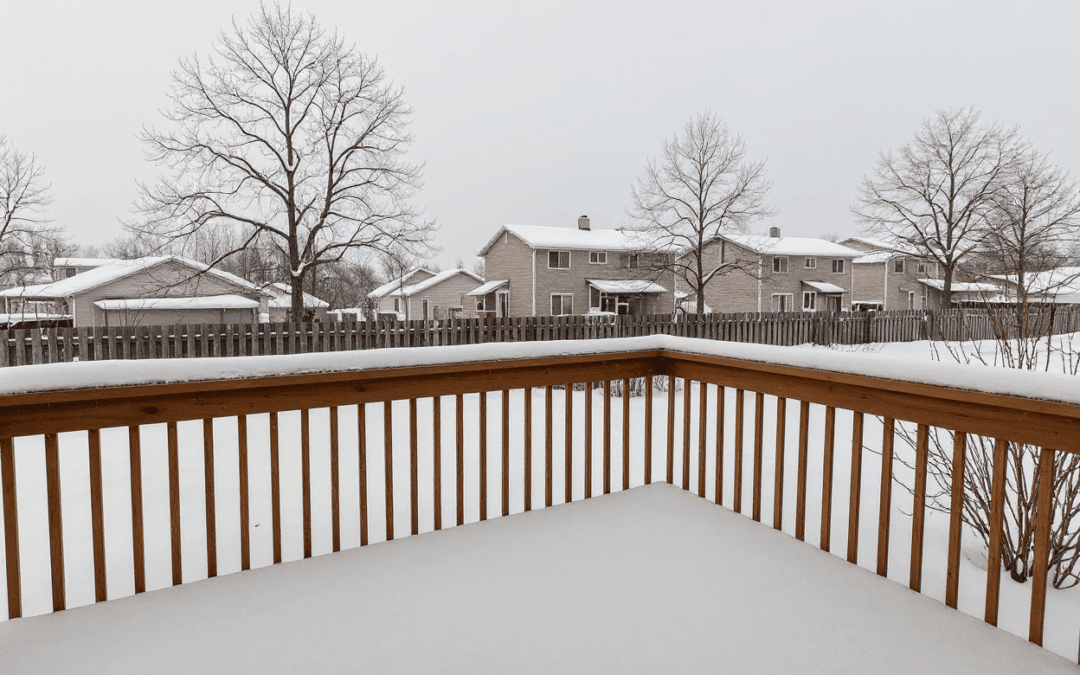By the time November rolls around in the Lower Mainland, most people are already in winter mode. The furniture is packed away, and outdoor entertaining has slowed to a stop. But your deck still needs attention. Ignoring it through the colder months can lead to rot, warping, and costly repairs come spring.
At All Hands on Deck, we have spent over two decades helping homeowners protect and enjoy their outdoor spaces. What you do in late fall can make a huge difference in how your deck holds up through the winter. We have seen small oversights lead to big damage, and we have also seen how a little preparation now can save a lot of money later.
Here is your step-by-step checklist to keep your deck in great shape this winter.
1. Remove All Furniture, Rugs, and Planters
The first step is clearing the space. Moisture trapped under outdoor items is one of the fastest ways to create rot spots and mildew.
What to do:
- Remove patio furniture and store it in a dry place
- Roll up and store outdoor rugs to prevent mold
- Empty planters and remove trays or pot risers
- Avoid leaving anything on the surface that can hold moisture
Even items that seem dry on top often trap water underneath. If you leave things in place, you are creating a breeding ground for decay.
2. Sweep and Clean Thoroughly
Do not just do a quick leaf blow. This is the time to get into the corners and really clean off organic material that holds moisture and feeds algae.
Steps:
- Sweep thoroughly, especially near railing posts and corners
- Use a stiff brush and a deck-safe cleaner for scrubbing
- Rinse with a hose, but make sure water does not pool anywhere
Avoid pressure washing unless you are very familiar with how to control the spray. It is easy to damage softer woods like cedar. Scrubbing by hand may take longer, but it is safer and more effective for seasonal cleaning.
3. Inspect for Damage Before Moisture Takes Hold
Moisture has a way of finding weaknesses. Cracks in the wood or loose fasteners become much worse when combined with the constant damp of British Columbia’s winters.
Take a slow walk across your deck and check:
- Are any boards soft or spongy when pressed
- Do you notice dark spots, warping, or deep cracks
- Are any railings loose or wobbly
- Can you spot any nails that have popped up
If anything feels off, it is better to address it now rather than waiting until spring. Moisture accelerates problems quickly in our climate.
If you are wondering whether your deck needs an upgrade or something more protective, take a look at covered decks versus open decks. Covered decks offer better protection during wet seasons and may be a smart investment.
4. Trim Back Overhanging Plants
Shrubs, vines, and trees that touch your deck are more than just an annoyance. They drip water onto your deck long after a rainfall and prevent sunlight from drying it out.
What to trim:
- Bushes or vines climbing onto railings
- Trees with overhanging branches
- Hedges leaning onto the edges of the deck
Try to leave at least one foot of space between any plant and your deck surface. That allows airflow and gives the wood a better chance to dry between storms.
5. Test the Water Resistance
Before the rain really settles in, check how well your deck repels water.
Here is how:
Pour a small amount of water on different parts of your deck. If it beads and sits on the surface, your seal is still working. If it sinks in right away, the surface is no longer protected.
That means it is time to reseal. Unsealed decks are far more likely to grow mold, absorb water, and develop deep cracks.
You will want to reseal during a dry, mild day. Fall is often the last chance before rain becomes a daily event.
6. Address Drainage Issues Right Away
If your deck has poor drainage or standing water, winter will only make things worse. In our region, it is common to see puddles collect in corners or along the edges.
Check for:
- Standing water after a light rainfall
- Water stains under the deck
- Splashback near the foundation of your home
- Sloping that pushes water toward the house
These are signs that you might need professional help. All Hands on Deck often handles drainage improvements as part of new deck builds. If you are unsure where the water is going, we can take a look and give honest feedback.
7. Seal Gaps and Exposed Edges
Pay close attention to where the deck meets other structures. Water often seeps in where different materials connect.
Watch these areas:
- Where the deck touches your home’s siding
- Around stair bases and stringers
- Under railings and vertical posts
- Around privacy screens or canopies
Use outdoor-rated caulking or waterproof sealant to close up these seams. This keeps out moisture and stops small critters from sneaking in.
8. Take a Look Under the Deck
The underside of your deck can show you problems before they appear on the surface.
If your deck is low to the ground, grab a flashlight and check for:
- Pools of water or muddy spots
- Evidence of rodents or nests
- Sagging joists or dark patches
- Rusted brackets or loose fasteners
Airflow is key. If the soil underneath is always wet or smells musty, you may need to install gravel or update the skirting to improve ventilation.
9. Use a Temporary Cover If Needed
If your deck is fully exposed, a seasonal waterproof canopy can help. It is not a permanent fix, but it can reduce direct rainfall and protect problem areas.
Some homeowners use custom tarps, angled polycarbonate sheets, or retractable fabric covers. This works well in damp zones that never get enough sun to dry out.
If you think your space needs a full cover or roof, we would be happy to help you design the right solution. Just request a quote to get started.
10. Book a Pre-Winter Inspection
Not every issue is easy to spot. You might not notice a failing connection or rotting substructure until it is too late.
At All Hands on Deck, we offer seasonal inspections for local homeowners who want peace of mind. We can spot:
- Weak framing or aging hardware
- Water damage beneath the surface
- Fasteners that need replacement
- Early signs of structural failure
If your deck is older or has not been maintained regularly, it is worth getting a second set of eyes on it before winter hits hard.
Take the Time Now and Save in the Spring
Protecting your deck in November is not about making it look perfect. It is about preventing damage, extending its life, and saving yourself a headache next season. Moisture builds fast in this region, and even small issues become big ones if left alone all winter.
A bit of time now can mean avoiding rot, warped boards, or even full rebuilds later on. If you are not sure what your deck needs, let us help you figure it out.Want a second opinion or ready to upgrade your deck for the wet season ahead? Request a quote from All Hands on Deck and get expert help grounded in experience.



Recent Comments